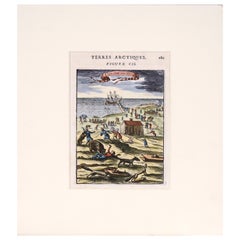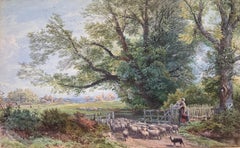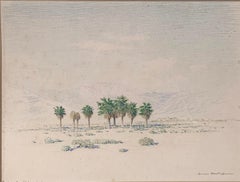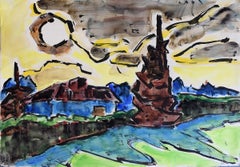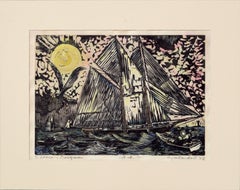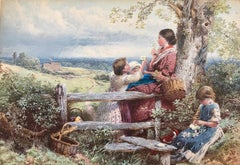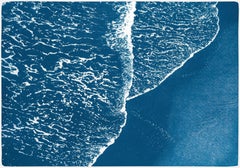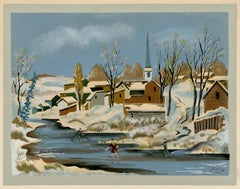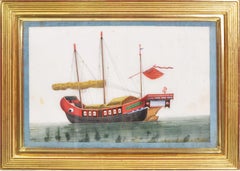Gouache Landscape Prints
to
5
5
2
4
Overall Width
to
Overall Height
to
3
2
1
1
1
2
1
1
1
1
1
2
4
4
1
2
7
3
1
5
4
4
3
2
2
2
2
1
1
1
1
1
1
1
1
1
1
1
1
6,056
6,840
3,634
2,687
1,395
4
8
3
Medium: Gouache
Rare Hand Colored "Cabane Des Hold" - 1st Ed "Description de l’Univers" C. 1683
Located in Soquel, CA
Rare Engraving "Cabane Des Hold, Terres Artiques, Fig CII," 1st edition "Description de l’Univers, page 281
This rare image depicts the Willem Barentsz expedition of 1597 to Novaya Zemlya, Russia. The engraving, with later hand-coloring, shows the cabin and ship of the Dutch arctic expedition of Barentsz on Novaya Zemlya (Nova Zembla), with the party being attacked (and in some cases apparently eaten) by bears and wolves. Dutch explorer, Willem Barentsz, reached the west coast of Novaya Zemlya in 1594, and in a subsequent expedition of 1596 rounded the northern point and wintered on the northeast coast. Barentsz died during the expedition, and may have been buried on the northern island.
This artwork is a page from a book by 17th century cartographer and engineer, Allain Manesson Mallet (French, 1630-1706), "Description de L'Univers, contenant les differents systêmes du monde, les cartes générals et particulières de la géographie ancienne et modern." Paris: Denys Thierry, 1683.
Presented in an cream colored mat.
Text on verso shown in images.
Mat Size: 11.5"H x 9.07"W
Paper Size: 8.25"H x 5.44"W
Image Size: 5.63"H x 3.75"W
Alain Manesson Mallet (French, 1630-1706) was a 17th century cartographer and military engineer. He started his career as a musketeer in the army of Louis XIV, became a Sergeant-Major in the artillery and an Inspector of Fortifications. He later served under Alfonso VI, King of Portugal...
Category
1680s Realist Gouache Landscape Prints
Materials
Paper, Ink, Gouache
“Tending the Sheep”
Located in Southampton, NY
Beautifully executed original hand colored lithograph using gouache and watercolor. Scene in Surrey, England. Signedxwith monogram in plate lower left, Myles Birket Foster. Published by M. H. Long. Condition is very good. In original 2 inch wide birdseye maple antique frame with thick museum mat with gold innner edge. Overall 22 by 26 inches.
Biography
Myles Birket Foster (4 February 1825 – 27 March 1899) was a popular English illustrator, watercolour artist and engraver in the Victorian period. His name is also to be found as Myles Birkett Foster.
Life and work
Foster was born in North Shields, England of a primarily Quaker family, but his family moved south to London in 1830, where his father founded M. B. Foster & sons — a successful beer-bottling company. He was schooled at Hitchin, Hertfordshire and on leaving initially went into his father's business. However, noticing his talent for art, his father secured an apprenticeship with the notable wood engraver, Ebenezer Landells, where he worked on illustrations for Punch magazine and the Illustrated London News.
On leaving Landells' employ, he continued to produce work for the Illustrated London News and the Illustrated London Almanack. He also found work as a book illustrator and, during the 1850s, trained himself to paint in watercolours. His illustrations of Longfellow’s Evangeline and books of poetry by other contemporaries were a great success, and he quickly became a successful artist in watercolours. Birket Foster became an Associate of the "Old" Watercolour Society (Later the Royal Watercolour Society) in 1860 and exhibited some 400 of his paintings at the Royal Academy over more than 2 decades.
Birket Foster travelled widely, painting the countryside around Scotland, the Rhine Valley, the Swiss lakes and in Italy, especially Venice. In 1863 he moved to Witley, near Godalming in Surrey where he had a house ("The Hill") built. Being friendly with Edward Burne-Jones and William Morris, he had the house decorated and furnished in contemporary style, with tiles and paintings by Burne-Jones and Morris' firm, Morris and Company. The same year he published a volume of "English Landscapes," with text by Tom Taylor...
Category
1880s Impressionist Gouache Landscape Prints
Materials
Lithograph, Watercolor, Gouache
$1,120 Sale Price
20% Off
OASIS OF SEVEN PALMS CALIFORNIA
Located in Portland, ME
Burr, George Elbert. OASIS OF SEVEN PALMS CALIFORNIA. Gouache on paper, not dated, but before 1921. Titled in pencil, lower left, and signed in pencil, lower right, and with the numb...
Category
Early 20th Century Gouache Landscape Prints
Materials
Gouache
Animated Autumn Landscape
Located in London, GB
KARL SCHMIDT-ROTTLUFF 1884-1976
Rottluff, Germany 1884 - 1976 Berlin (German)
Title: Animated Autumn Landscape Bewegte Herbstlandschaft, 1967
Technique: Signed and Dated Brush, I...
Category
1960s Expressionist Gouache Landscape Prints
Materials
Ink, Watercolor, Gouache
"Schooner + Doryman" First Edition Hand-Colored Woodblock Print
Located in Soquel, CA
Bold woodblock print by Byron Randall (American, 1918-1999). Titled "Schooner + Doryman", numbered "1st ed.", and signed and dated "Byron Randall '62" along the bottom edge. Small am...
Category
1960s American Modern Gouache Landscape Prints
Materials
Gold Leaf
$920 Sale Price
20% Off
“Flower Picking”
Located in Southampton, NY
Beautifully executed original hand colored lithograph using gouache and watercolor. Scene in Surrey, England. Signedxwith monogram in plate lower left, Myles Birket Foster. Published by M. H. Long. Condition is very good. In original 2 inch wide birdseye maple antique frame with thick museum mat with gold innner edge. Overall 22 by 26 inches.
Biography
Myles Birket Foster (4 February 1825 – 27 March 1899) was a popular English illustrator, watercolour artist and engraver in the Victorian period. His name is also to be found as Myles Birkett Foster.
Life and work
Foster was born in North Shields, England of a primarily Quaker family, but his family moved south to London in 1830, where his father founded M. B. Foster & sons — a successful beer-bottling company. He was schooled at Hitchin, Hertfordshire and on leaving initially went into his father's business. However, noticing his talent for art, his father secured an apprenticeship with the notable wood engraver, Ebenezer Landells, where he worked on illustrations for Punch magazine and the Illustrated London News.
On leaving Landells' employ, he continued to produce work for the Illustrated London News and the Illustrated London Almanack. He also found work as a book illustrator and, during the 1850s, trained himself to paint in watercolours. His illustrations of Longfellow’s Evangeline and books of poetry by other contemporaries were a great success, and he quickly became a successful artist in watercolours. Birket Foster became an Associate of the "Old" Watercolour Society (Later the Royal Watercolour Society) in 1860 and exhibited some 400 of his paintings at the Royal Academy over more than 2 decades.
Birket Foster travelled widely, painting the countryside around Scotland, the Rhine Valley, the Swiss lakes and in Italy, especially Venice. In 1863 he moved to Witley, near Godalming in Surrey where he had a house ("The Hill") built. Being friendly with Edward Burne-Jones and William Morris, he had the house decorated and furnished in contemporary style, with tiles and paintings by Burne-Jones and Morris' firm, Morris and Company. The same year he published a volume of "English Landscapes," with text by Tom Taylor...
Category
1880s Impressionist Gouache Landscape Prints
Materials
Lithograph, Watercolor, Gouache
$1,120 Sale Price
20% Off
Landscape #125
Located in Palm Springs, CA
Untitled landscape of trees against a stormy sky. Signed by the artist, with full information of signature on verso.
RENAUD ALLIRAND was born in 1970, and currently lives and works ...
Category
2010s Contemporary Gouache Landscape Prints
Materials
Gouache, India Ink
$280 Sale Price
20% Off
Blue Flight / monoprint
By Kim Frohsin
Located in Burlingame, CA
Monotype ev edition 3/4 with heavy hand coloring. The plate is 28 x 28 inches and the overall paper size is 33 1/2 x 32 inches. Signed, titled and dated. Kim Frohsin spend 12 years w...
Category
21st Century and Contemporary Contemporary Gouache Landscape Prints
Materials
Gouache, Mixed Media, Monotype, Pastel
Rising Water - Abstract Seascape Woodcut Print, Waves and Beach in Blue + Black
By Keith Purser
Located in Kingsclere, GB
Keith Purser b. 1944
Rising Water, 2007
woodcut with hand-colouring in gouache
42 x 59 cm
16 1/2 x 23 1/4 in
signed, dated and titled in pencil
Keith Purser lives and works on the e...
Category
21st Century and Contemporary Gouache Landscape Prints
Materials
Gouache, Woodcut
Landscape with Tree and Houses
Located in London, GB
HUGO SCHEIBER 1873-1950
1873 - Budapest-1950 (Hungarian)
Title: Landscape with Tree and Houses, circa 1930's
Technique: Signed Gouache and Pastel Painting on Paper
Size: 67.5 x 48...
Category
1930s Art Deco Gouache Landscape Prints
Materials
Pastel, Gouache
Glebe House, Morning
By Randall Exon
Located in New York, NY
Unframed
Category
2010s Contemporary Gouache Landscape Prints
Materials
Gouache, Monotype
Related Items
Hand-Painted Artist Proof-Summer Night-British Awarded Artist-One Off large size
Located in London, GB
This stunning Artist's Proof is an one-off, hand-painted by the artist Shizico , signed at front and on the back label too; the proof is 90% hand painted with original oil paint by S...
Category
2010s Abstract Impressionist Gouache Landscape Prints
Materials
Gesso, Archival Ink, Acrylic, Archival Paper, Giclée
$403 Sale Price
20% Off
H 39.38 in W 27.56 in D 0.04 in
Blue Pacific Foamy Shorelines, Horizontal Calm Seascape, Minimal Waterscape
By Kind of Cyan
Located in Barcelona, ES
This is an exclusive handprinted limited edition cyanotype.
"Pacific Foamy Shoreline" is a handmade cyanotype print portraying a smooth wave reaching the shore.
Details:
+ Title: Pa...
Category
2010s Minimalist Gouache Landscape Prints
Materials
Watercolor, Lithograph, Paper
Blue Tones Triptych, Serene Gorgeous Clouds, Handmade Cyanotype Watercolor Paper
By Kind of Cyan
Located in Barcelona, ES
This series of cyanotype triptychs showcases the beauty of nature scenes, including stunning beaches and oceans, as well as the intricate textures of w...
Category
2010s American Realist Gouache Landscape Prints
Materials
Emulsion, Lithograph, Monotype, Handmade Paper
Degas, Melina Darde, Ten Ballet Sketches (after)
By Edgar Degas
Located in Fairfield, CT
Medium: Lithograph and stencil on vélin paper
Year: 1945
Paper Size: 17 x 13 inches
Inscription: Signed in the plate and unnumbered, as issued
Notes: From the folio, Degas, Ten Balle...
Category
1940s Impressionist Gouache Landscape Prints
Materials
Lithograph
Forest Triptych, Looking Up Through The Trees, Blue Nature, Handmade Cyanotype
By Kind of Cyan
Located in Barcelona, ES
This series of cyanotype triptychs showcases the beauty of nature scenes, including stunning beaches and oceans, as well as the intricate textures of w...
Category
2010s Naturalistic Gouache Landscape Prints
Materials
Lithograph, Paper
Authentic Japanese Woodblock Print-White Cat-Hanabusa Itchō-Edo-Re-carved 1920s
Located in London, GB
This rare Original 1920s authentic print is a Taisho Period Woodblock print published from the Japan 1920's The Nippon Mokuhan Gasui, Masterpieces Series.;
it is authentically hand ...
Category
1920s Edo Gouache Landscape Prints
Materials
Ink, Handmade Paper
$391 Sale Price
30% Off
H 11.82 in W 7.72 in D 0.04 in
Romantic Landscape of Scandinavian Enchanted Forest, Large Lake Print Cyanotype
By Kind of Cyan
Located in Barcelona, ES
This is an exclusive handprinted limited edition cyanotype.
Lovely scene of a hidden pond in a Scandinavian forest.
Details:
+ Title: Scandinavian Enchanted Forest
+ Year: 2024
+ ...
Category
2010s Romantic Gouache Landscape Prints
Materials
Photographic Film, Emulsion, Watercolor, Photographic Paper, C Print, Co...
$336 Sale Price
20% Off
H 28 in W 40 in
The Grand Canal, Venice
By Elias S. Mandel Grossman
Located in Middletown, NY
1926. Etching in sepia ink on Japon paper, 9 5/8 x 11 1/2 inches (245 x 292 mm), full margins with the lower margin slightly notched. Signed, titled and dated in pencil in the lower ...
Category
Early 20th Century American Modern Gouache Landscape Prints
Materials
Handmade Paper, Etching
Waves of Clouds, Deep Blue Cyanotype Print, Pleasant Cloudy Sky, Large Triptych
By Kind of Cyan
Located in Barcelona, ES
This series of cyanotype triptychs showcases the beauty of nature scenes, including stunning beaches and oceans, as well as the intricate textures of water, forests, and skies. These triptychs are large pieces that feature lush blues, making them an impressive addition to any beautifully designed space.
Each triptych is printed by hand and carefully crafted to capture the unique essence of these natural environments, with a focus on the interplay of light and shadows, and the subtle nuances of tone and texture.
The beach and ocean scenes depict the dynamic beauty of waves crashing against the shore, with the cyanotype process lending a dreamy, ethereal quality to the images. Similarly, the forest and wood scenes...
Category
2010s American Realist Gouache Landscape Prints
Materials
Lithograph, Rag Paper
Mediterranean Seascape, Nautical Cyanotype on Watercolor Paper, Blueprint
By Kind of Cyan
Located in Barcelona, ES
This is an exclusive handprinted limited edition cyanotype.
"Mediterranean Blue Sea Waves" is a handmade cyanotype print of the subtle tidal flow moving in on the Mediterranean Sea.
...
Category
2010s Realist Gouache Landscape Prints
Materials
Emulsion, Watercolor, Rag Paper, Lithograph
Realist Skyscape Triptych in Blue Tones of Serene Cloudy Sky, Handmade Cyanotype
By Kind of Cyan
Located in Barcelona, ES
This series of cyanotype triptychs showcases the beauty of nature scenes, including stunning beaches and oceans, as well as the intricate textures of water, forests, and skies. These...
Category
2010s Realist Gouache Landscape Prints
Materials
Paper, Emulsion, Lithograph
Bridgetown Barbados, Oil Monotype by Romare Bearden
Located in Long Island City, NY
A unique oil print by Romare Bearden circa 1980. A bright city scene illustrated in a modern expressionist style.
Artist: Romare Bearden, American (1911 - 1988)
Title: Bridgetown, ...
Category
1980s Expressionist Gouache Landscape Prints
Materials
Monoprint, Oil
$125,000
H 29.5 in W 36 in
Previously Available Items
'Skaters' — 1930s Woodstock, New York
By Emil Ganso
Located in Myrtle Beach, SC
Emil Ganso, 'Skaters', pochoir (color stencil) with hand painting, edition c. 50, 1938, Smith S-6. Signed in the image, lower right. A rich, painterly impression, with fresh colors, on buff wove paper; the full sheet with margins (7/8 to 1 7/8 inches), in excellent condition. Matted to museum standards, unframed.
Image size 11 3/4 x 15 1/4 inches; sheet size 18 3/4 x 13 3/4 inches.
An impression of this work is in the permanent collection of the Philadelphia Museum of Art.
ABOUT THE ARTIST
Born in Germany, Emil Ganso (1895-1941) came to the United States with his family in 1912. After settling in New York City, he found night work in a bakery and concentrated on his art in the daytime—mostly self-taught at this time, he studied only briefly at the National Academy of Design.
In 1924, Ganso showed his drawings to Carl Zigrosser, who organized the artist’s first solo exhibition, at the Weyhe Gallery. Soon afterward, Ganso enrolled in Eugene Fitsch’s printmaking class at the Art Students League.
Although he considered himself primarily a painter, Ganso made prints in all media, including relief and stencil prints and complex intaglios, and even experimented with color lithography in the late 1920s. He also developed, with an engineer, the design and fabrication of an innovative etching press.
In 1926, Ganso attended the Art Students League summer session in Woodstock, New York. There, he met Jules Pascin, and the two artists began a close friendship, briefly sharing a studio. Ganso followed Pascin to Europe in 1928.
In 1929, Ganso returned to New York and showed his work regularly in group exhibitions. He continued working in Woodstock in the summer months, often printing lithographs for other artists. The Cleveland Print Club...
Category
1930s American Impressionist Gouache Landscape Prints
Materials
Gouache, Stencil
A Group of Twelve Chinese Junks and Barges.
Located in London, GB
[China Export Water-colours on Pith Paper].
A Group of Twelve Chinese Junks and Barges.
c. 1860.
Water-colour and gouache studies on pith paper, edged in blue silk ribbon.
The vessels depicted include variants of the traditional flat-bottomed Junk, the similar but European-hulled Lorcha, State and pleasure barges, and a large floating duck house...
Category
1830s Qing Gouache Landscape Prints
Materials
Watercolor, Gouache, Rice Paper
Autumn — Woodstock, NY
By Emil Ganso
Located in Myrtle Beach, SC
Emil Ganso, 'Autumn', color pochoir (stencil), c. 1930s, edition 50, Smith S-2. Signed in pencil, in the image border, lower right. Annotated '7 Stencil Print ED 50' in pencil, in the image border, lower left. A rich, painterly impression, with fresh colors, on buff wove paper, with full margins (1 1/2 to 1 3/4 inches). Slight rippling at the top and bottom sheet edges; overall toning verso not affecting the image; otherwise in good condition. Image size 10 3/4 x 14 7/8 inches; sheet size 13 3/4 x 18 1/4 inches. Matted to museum standards, unframed.
An impression of this work is in the permanent collection of the Philadelphia Museum of Art.
ABOUT THE ARTIST
Born in Germany, Emil Ganso (1895-1941) came to the United States with his family in 1912. After settling in New York City, he found night work in a bakery and concentrated on his art in the daytime. Mostly self-taught, he studied briefly at the National Academy of Design.
In 1924 Ganso showed his drawings to Carl Zigrosser at the Weyhe Gallery, who organized the artist’s first solo exhibition. Soon after that, Ganso enrolled in Eugene Fitsch’s printmaking class at the Art Students League.
Ganso produced prints in many mediums, including relief, pochoir (stencil), lithography, and intaglio. His expressionist approach to printmaking was that of a painter, rather than a draftsman, but many of his graphic works exhibited technical sophistication. He also began experimenting with color lithography in the late 1920s, and he collaborated with an engineer to design and fabricate an innovative etching press.
In 1926 Ganso attended the summer session of the Art Students League in Woodstock, New York, where he met Jules Pascin. The two artists began a close friendship briefly sharing a studio, and Ganso followed Pascin to Europe in 1928, where he was exposed to progressive European art movements and advanced printmaking techniques.
Ganso returned to New York in 1926 and his work was shown regularly in group exhibitions. In the summer months, he continued to work in Woodstock, where he frequently printed lithographs for other artists. The Cleveland Print Club...
Category
1930s American Impressionist Gouache Landscape Prints
Materials
Gouache, Stencil
Untitled Gouache Painting of a Plaza
By Frank Freed
Located in Houston, TX
Untitled gouache painting on paper of a city and buses by artist Frank Freed in the 1960s.
Dimensions without Frame: H 19.5 in x W 15 in.
Artist Biography:
Frank Freed was born in S...
Category
1960s American Modern Gouache Landscape Prints
Materials
Gouache
Monsoon - Abstract, Figurative, Howard Hodgkin, Lithograph, Gouache, Watercolour
Located in London, GB
Lithograph with hand-colouring in watercolour and gouache, 1987-88.
Signed and dated in pencil, numbered from the edition of 85.
Printed on Arches Cover paper by Solo Press Inc., N...
Category
1980s Abstract Gouache Landscape Prints
Materials
Watercolor, Gouache, Lithograph
Untitled (Guache Painting of City)
By Frank Freed
Located in Houston, TX
Untitled gouache painting on paper of a city and buses by artist Frank Freed in the 1960s.
Dimensions without Frame: H 19.5 in x W 15 in.
Artist Biography:
Frank Freed was born in S...
Category
1960s American Modern Gouache Landscape Prints
Materials
Gouache
Gouache landscape prints for sale on 1stDibs.
Find a wide variety of authentic Gouache landscape prints available on 1stDibs. While artists have worked in this medium across a range of time periods, art made with this material during the 21st Century is especially popular. If you’re looking to add landscape prints created with this material to introduce a provocative pop of color and texture to an otherwise neutral space in your home, the works available on 1stDibs include elements of purple and other colors. There are many well-known artists whose body of work includes ceramic sculptures. Popular artists on 1stDibs associated with pieces like this include Myles Birket Foster, Renaud Allirand, George Elbert Burr, and Randall Exon. Frequently made by artists working in the Contemporary, Impressionist, all of these pieces for sale are unique and many will draw the attention of guests in your home. Not every interior allows for large Gouache landscape prints, so small editions measuring 0.01 inches across are also available
